|

Girls to Women:
Coming of Age Rituals
by Brenda Sutton
[Images: "Reading Torah" © Steve Rosenbach,
"Estan-ah-Tlehay" © Sandra M. Stanton, used with permission]
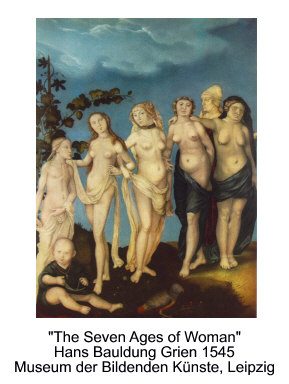 Ask yourself, "When did I first feel like an adult?" Ask yourself, "When did I first feel like an adult?"
Once upon a time in the Jurassic feminism of the 1960s, all of the boys in my fifth-grade class were dismissed to play a guys-only kickball game. When the door closed behind them, my teacher passed out permission slips for a private event, and instructed us girls to take them home for our mothers' signatures. In my childhood's generation, the normal physical changes of young womanhood were taught by the school nurse in a clandestine meeting in the cafeteria. The boys on the A/V team set up the film projector, showed the nurse which button to push to start it, and then left the room. Only girls whose mothers accompanied them were allowed to see the mysterious film and receive the secret handshakes, special instructions and tools. My newly liberated working mom was unable to get the day off, and so I stood outside, ear pressed to the door, confused and frustrated. No one would tell me what was going on in that locked room. The same no-show scenario played out in the sixth grade. Fortunately, the school nurse took pity on me. "I'm not supposed to do this, but...here," she said, handing me small box and a brochure, "take this home and read it."
According to the powder pink and baby blue brochure, I was going to become a woman sometime soon. A year and a half later when the transition finally happened, I remember huddling in my bed after a fumbling hour in the bathroom thinking, "I'm a woman now. I'm a woman now. I'm a woman now..." but I didn't feel any different than I had an hour before when I had been a child. Not much of a transition, and certainly an inadequate rite of passage.
Shakespeare handily identified the seven ages of a man's life in a speech from As You Like It, but he didn't write a similar speech on the ages of women. It's not hard to imagine where the roads might part. Some of the categories would stay the same. Baby girls mewl and puke right along with our brothers. We, too, toddle off to school. Up until recently, the feminine passive role in love differed from that of active male suitors, but we share youthful passion. There's one dividing love line, though. In the not far recent past, many a woman with no bride price or dowry transitioned from being the one who carded the wool, to the one who spun the wool — a spinster, or old maid who later became the aged single aunt, knitting away her solitary life.
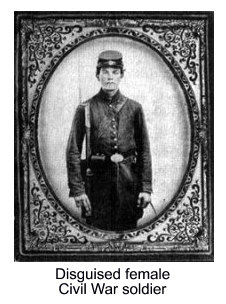 As for the warrior's way, there are examples like the Fa Mulan legends in China, and several Soldier Maid stories in Europe and the Americas of the young girl who cuts off her hair, binds her breasts, and enlists in the military until she is inevitably betrayed by love. Scandinavian Valkeries, Celtic female war chieftains like Boudicea, and Etruscan Amazons — female warriors abound in many societies. However, although many women may serve valiantly in the military, it's not the usual female path. Far more venture into marriage and motherhood. We do share Shakespeare's description of middle age with the paunch and the shrunken shank. On to the final stages: the second childhood; and, because no one gets off the planet alive, death. It's that middle ground, the part between school and paunch, which separates women's rites of passage from those of men. As for the warrior's way, there are examples like the Fa Mulan legends in China, and several Soldier Maid stories in Europe and the Americas of the young girl who cuts off her hair, binds her breasts, and enlists in the military until she is inevitably betrayed by love. Scandinavian Valkeries, Celtic female war chieftains like Boudicea, and Etruscan Amazons — female warriors abound in many societies. However, although many women may serve valiantly in the military, it's not the usual female path. Far more venture into marriage and motherhood. We do share Shakespeare's description of middle age with the paunch and the shrunken shank. On to the final stages: the second childhood; and, because no one gets off the planet alive, death. It's that middle ground, the part between school and paunch, which separates women's rites of passage from those of men.
According to German ethnographer Arthur van Gennep, rites of passage have three transitional stages (geographical, social, and spiritual) in one's life time: separation, transition, and reincorporation. Usually, we understand them as the stages from birth to death. But it is also the process between the two stages, or within each stage. In the first phase, the person withdraws from the group and begins moving from one place or status to another. In the second liminal phase, the person has left one place or state but not yet entered the next. In the third phase, they reenter society, having completed the rite.
How important is it for one's community to acknowledge a young girl's journey from child to adult?
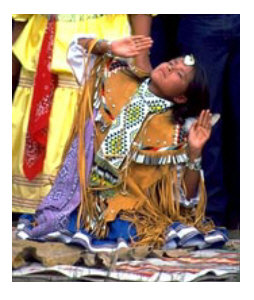 The Apache Sunrise Ceremony is a good example of a female rite of passage that encompasses all three phases. The performance of this ritual was banned in the US government's efforts to erase Native American culture. When the ceremony was decriminalized by the American Indian Religious Freedom Act in 1978, the ritual returned to resume its place as one of the most important events in an Apache female's life. Called na'ii'ees, the word means "molding of a person.". The ritual imbues young women at the age of 13 with the spirit and characteristics of White Painted Woman, the Apache culture's first woman — she who is called Esdzanadehe or Changing Woman. The Apache Sunrise Ceremony is a good example of a female rite of passage that encompasses all three phases. The performance of this ritual was banned in the US government's efforts to erase Native American culture. When the ceremony was decriminalized by the American Indian Religious Freedom Act in 1978, the ritual returned to resume its place as one of the most important events in an Apache female's life. Called na'ii'ees, the word means "molding of a person.". The ritual imbues young women at the age of 13 with the spirit and characteristics of White Painted Woman, the Apache culture's first woman — she who is called Esdzanadehe or Changing Woman.
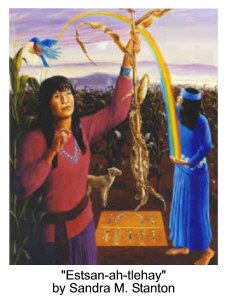 The first woman survived the Great Flood in an abalone shell. She wandered the land while the waters receded. Stranded atop a mountain, she was impregnated by the sun and gave birth to a boy called the Killer of Enemies. Then she was impregnated by the Rain, and gave birth to the Son of Water. The world was made safe when White Painted Woman's sons killed the Owl Man Giant. Upon their triumphant return from their victory, White Painted Woman expressed a cry of exaltation and delight, which later is echoed by the godmother or sponsor during the Sunrise Ceremony. White Painted Woman was then guided by spirits to create a puberty rite for all daughters of her people. She instructed the women of the tribe in the ritual and the rites of womanhood. When she becomes old, White Painted Woman walks east toward the sun until she meets her younger self, merges with it, and becomes young again. She is born again and again, from generation to generation. The first woman survived the Great Flood in an abalone shell. She wandered the land while the waters receded. Stranded atop a mountain, she was impregnated by the sun and gave birth to a boy called the Killer of Enemies. Then she was impregnated by the Rain, and gave birth to the Son of Water. The world was made safe when White Painted Woman's sons killed the Owl Man Giant. Upon their triumphant return from their victory, White Painted Woman expressed a cry of exaltation and delight, which later is echoed by the godmother or sponsor during the Sunrise Ceremony. White Painted Woman was then guided by spirits to create a puberty rite for all daughters of her people. She instructed the women of the tribe in the ritual and the rites of womanhood. When she becomes old, White Painted Woman walks east toward the sun until she meets her younger self, merges with it, and becomes young again. She is born again and again, from generation to generation.
Na'ii'ees usually take place over a Friday to Monday in the spring and early summer. During the physically demanding ritual, the girl's skin is painted with a sacred mixture of pollen, clay and cornmeal which must not be removed during the entire ceremony. She sits for long hours with her back perfectly straight. She prays towards the east at dawn and in the four cardinal directions representing the four stages of life. She dances, and dances, and dances — a simple two-step pattern, but eventually the body and mind falls into an exhausted trance state. One pause or misstep could mean an ill omen in her future. Her body is physically molded, as White Changing Woman was molded. It is a test of endurance during which she is given instruction in self-esteem, dignity, confidence, sexuality, and healing ability. It takes the combined labor and income of nearly four sets of extended families to hold this complicated ritual. A Sunrise Dance can cost anywhere from $7,000 to $13,000 to pay for the dancers, the medicine man who will sing 62 songs in the completion of the four-day ceremony, the food and labor, ceremonial garb for the key people, not to mention the traveling costs to bring everyone together.
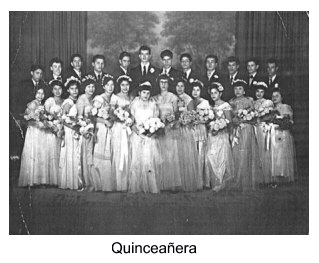 In many Latin countries, a young woman may still participate in Quinceañera or Quince Años (Fifteen Years) which involves the casting aside of a favorite doll, the move from flat shoes to high heels, and an elaborate ball with fifteen dancing couples. Although the celebration is now more secular and social than religious, it still includes a mass for the blessings of the Virgin Mother. The young woman dressed in formal white, her shoulders cloaked, is crowned by her mother or a friend. In many Latin countries, a young woman may still participate in Quinceañera or Quince Años (Fifteen Years) which involves the casting aside of a favorite doll, the move from flat shoes to high heels, and an elaborate ball with fifteen dancing couples. Although the celebration is now more secular and social than religious, it still includes a mass for the blessings of the Virgin Mother. The young woman dressed in formal white, her shoulders cloaked, is crowned by her mother or a friend.
Fifty to a hundred years ago, a Western woman may have experienced entrance into adult society through a "Coming Out" party, debutante's ball, or other gala event, followed by marriage and children. Roll into the modern age, and even those rites of passage have been watered down to what is now known as "Prom Night."
But what of the young girl who never goes to the prom, who doesn't enjoy an evening of whirling couples and limo rides? How does a young girl learn pride in herself when the natural changes of her body are considered taboo, unclean, and disguised by language of double entendre and innuendo? What marks her journey to maturity?
I know too many invisible women who have been denied acceptance or recognition of important transitions by either family or community. They often desperately cobble together lonely, destructive, unsatisfying Pass/Fail rituals of anorxia, bulemia, self-mutilation, and depression. But I've also seen strength and self-mastery manifested in the lives of women who've enjoyed ritual recognition when they've chosen a direction to dance at liminal crossroads.
We know that the transition from child to adult has no firm dividing line. No one goes to sleep one night to wake up an adult in the morning, and some folks of advanced years manage to remain childish or childlike all the days of their lives. Most women don't tend to talk about their rites of passage unless it's part of a 12-Step Program, but conversations on the topic inevitably result in someone saying, "Women don't need rites of passage. Their bodies tell them when they transition from girl to woman, from bride to wife, from mother to crone." I don't agree — I don't agree at all. The epidemic of women affected by disorders connected directly to low self-esteem are muted cries for the wisdom of mentors, elders, teachers, parents, and friends. If unmuted, I believe that young girls would shout, "Show me, lead me, help me take these leaps!" If you had to choose between silent, solitary exploration of an unknown and frightening destination, or the company of wise, experienced guides, which would you prefer? Me? I'd take the advice a well-trained Sherpa every time.
Does your community or spiritual society recognise or ritualize a young woman's move from child to adult? If the answer to that question is no, why not?
Two women of my coven approached me when their daughters were around age 9 - 10 asking if we could conduct a ritual to mark this important move from child to young woman. We had some time, so we went into serious mull mode for a while, talking with other coven leaders and participating in different rites at pagan gatherings. Time passed rather swiftly, as it will, and the anxious mothers and I put our heads together to craft a personal ritual that we felt would be meaningful and celebratory.
The morning of the ritual, the parents awakened their daughters and treated them as if they were very small children. Mama picked out her baby's clothing, fixed her favorite foods, and directed every step. The daughters were instructed to spend the day going through their rooms removing every symbol of childhood. Childish clothing was packed away, thrown away, or given away to charity. Toy boxes were cleaned out; stuffed animals were taken from beds. The daughters were allowed to keep a few sentimental treasures, but these were placed high on shelves where they could be seen. One very special item was set aside for use in ritual later that night.
After traveling to the ritual site, the Mothers robed themselves in black or green, and the Daughters in white. Both Mothers and Daughters were cloistered in a darkened room lit by a single candle. The women of the coven, acting as Aunts, entered the torch lit circle space and stood around the center balefire. The altar, draped in red, was festooned in unblossomed spring flower buds, unsprung pussy willows and cat tails.
A special woman chosen by the Daughter to stand as her Aunt entered the cloister room in silence. The Aunt tied a slipknot in both ends of a long skein of red ribbon, pulling a loop of ribbon through that was large enough to go around the waist of the Mother on one end and around the Daughter on the other. The excess ribbon was gathered up and placed in the Mother's left hand. The Daughter was given her favorite toy to hold in her arms. Her Aunt tied a red lace or gauze scarf loosely over the Daughter's eyes, obsuring her vision but not so much that she could not see to walk. No words were spoken, but only smiles exchanged. The Aunt offered Mother and Daughter a kiss, and then lead them out to the circle area.
As they approached, the only sounds were the usual forest songs, a deep, low drum played like a heartbeat, and the Aunts chanting. The women of the circle joined hands, spiraling widdershins (anti-clockwise). The two tallest women stopped near the circle entrance and joined hands, forming the arch of a human tunnel. The rest of the women followed under the arch of arms to form their own arching pairs. They created a spiraling tunnel around the bale fire, each pair's arch getting lower and closer to the ground, until it ended the eastern quadtrant of the circle. I entered the tunnel and the Mothers followed me, one at a time. The red cord around her waist played out until she eventually pulled her Daughter into the tunnel. As each Daughter entered the tunnel, passing under the arching arms, the chanting changed from humming to the words. "Push! Push! Push! Push!"
When the Mother exited the tunnel in the east, women washed her face with a wet cloth and dried it with a towel. The Mother stood astride with her back to the end of the tunnel, her robes essentially sealing the entrance. I knealt, candle in hand — as the priestess of Hecate, goddess of midwives, once stood between the legs of laboring women — to guide the spirit of the new life into the world. I raised the Mother's robe just high enough to allow a little light into the tunnel and beckoned.
Her Aunt took up the red cord and continued to pull the Daughter through the tunnel, under her Mother's legs, out into the firelight and into welcoming arms. The Aunt then removed the gauzy blindfold. When both Daughters were through the tunnel, the pair of women who formed the end arch re-entered the tunnel and unwound it deosil (clockwise).
Once all had returned to stand in the circle, my Handmaiden and I washed and dried the Daughter's face, and wrapped a blanket around her shoulders. The Mother fed her child from a cup of milk and honey. If you're not expecting milk to taste so sweet, the honey goes straight to the back of the throat, and much coughing ensued. It was much like burping the baby.
From this point forward, we no longer refered to the Daughter as Child but only as Sister. This was the beginning point of community recognition of her new accepted status. We called upon the Maiden in Her morning light of the East and for Her blessings of intelligence, imagination, and inspiration for our new sisters. We sought the Warrior in the noonday sun of the South for her gifts of energy, will, and passion. We summoned the Mother in the evening sunset of the West requesting love, creativity, and empathy. And we beseeched the Crone in the midnight dark of the North for health, strength, and prosperity.
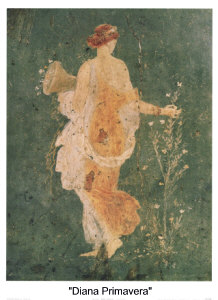 "Oh, Mighty Diana, Maiden Huntress, Silver Crescent, Forest Guardian, Wild Woman! We honor you in your woodland grove, here separated and shielded from the eyes of Man. Let your wisdom, Your love and Your power fill these sisters as they enter into womanhood. Teach them the magick of the Moon, the mysterious cycles of their Tides, and the glory of their physical Temple. Fill them with joy and beauty, awe and respect for their transformation. Run with them as they hunt their dreams. Great Goddess, share your strength, wisdom, and freedom." "Oh, Mighty Diana, Maiden Huntress, Silver Crescent, Forest Guardian, Wild Woman! We honor you in your woodland grove, here separated and shielded from the eyes of Man. Let your wisdom, Your love and Your power fill these sisters as they enter into womanhood. Teach them the magick of the Moon, the mysterious cycles of their Tides, and the glory of their physical Temple. Fill them with joy and beauty, awe and respect for their transformation. Run with them as they hunt their dreams. Great Goddess, share your strength, wisdom, and freedom."
Then the Mother addressed her daughter with the words of the poet, Judith Wright:
Mothers to Daughters
You who were darkness warmed my flesh
Where out of darkness rose the seed.
Then all a world I made in me;
All the world you hear and see
Hung upon my dreaming blood.
There moved the multitudinous stars,
And colored birds and fishes moved.
There swam the sliding continents.
All time lay rolled in me, and sense,
And love that knew not its beloved.
O node and focus of the world;
I hold you deep within that well
You shall escape and not escape —
That mirrors still your sleeping shape;
That nurtures still your crescent cell.
I wither and you break from me;
Yet though you dance in living light,
I am the earth, I am the root,
I am the stem that fed the fruit,
The link that joins you to the night.
The Mother gifted her Daughter with a beautiful ruby ring in a golden band on her right hand, and asked, "Do you have any gift for me?" The only thing each Daughter held was that one special toy, which they relinquished. There was a little fear expressed that it might be cast into the fire, but with stern assurance the Mother then commanded her Daughter to kneel in the East. The Aunt stood behind the Daughter and placed her hands on the young women's shoulders. Each Mother slowly backed away from her Daughter, moving deosil, first South and then West. With the Daughter in the East and the Mother in the West, the red umbilical cord that connected them was pulled directly over the bale fire in the center of the circle, its flames severing the link. The Aunt gathered up the remnant of the cords, making sure that the burned ends were extinguished. She took the cords from the waists of the new Sister, removed the swaddling blanket, and led her charge to the altar and away from her Mother, now left holding only the discarded toy.
 In places of honor and with great merriment, the Aunt plaited the Sister's hair, holding it in place with polished combs. She was gifted with a beautiful handkerchief to help with Life's tears of joy and sorrow, and with a silver mirror and comb — ancient feminine symbols of fertility and beauty. Her cheeks and lips were rouged, her arms were anointed with perfumed oil, and the women of the coven embraced her with blessings. Then came a feast that the men of the coven joined for the presentation of many more personal gifts to honor this new path on the road to adulthood. In places of honor and with great merriment, the Aunt plaited the Sister's hair, holding it in place with polished combs. She was gifted with a beautiful handkerchief to help with Life's tears of joy and sorrow, and with a silver mirror and comb — ancient feminine symbols of fertility and beauty. Her cheeks and lips were rouged, her arms were anointed with perfumed oil, and the women of the coven embraced her with blessings. Then came a feast that the men of the coven joined for the presentation of many more personal gifts to honor this new path on the road to adulthood.
It's been a couple of years since that ceremony. Both of the girls who participated that night have blossomed into beautiful, respectful young women. They've assumed roles of responsibility and are developing mature personalities. I spent some time talking with one of them recently about her memories of that night. She remembered the change to her room, and her confidence in placing the symbols of childhood behind her. She recalled being nervous and a little frightened at the weirdness of entering that dark, physical tunnel. She held an image of her mother's face with smiles and tears. She loved having her favorite Aunt plait her hair, and the gifting that followed.
I asked her if she felt any different before and after the ceremony, and she confessed that the women of the coven treat her with respect, but that most of the men still see her as a child. That gave me pause, for I believe part of the reason is because the men don't participate in this important ceremony until the partying begins. I wondered what could be added to this transition ceremony to make it even more meaningful to the girls and our community. The answer came when I had the opportunity to interview a young woman named Allie Linowes about her Bat Mitzvah ceremony, the Coming of Age for young Jewish women.
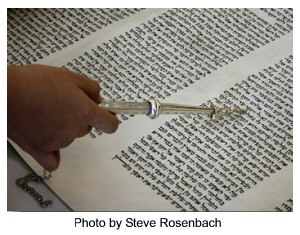 "Bat Mitzvah" means "one to whom the commandments apply," or literally, "daughter of the commandment". The Bat Mitzvah is schedule on or near the girl's 13th birthday. Although young men have been participating in a similar Bar Matzvah ceremony for ages, the first Bat Mitzvah ceremony didn't happen until 1922. Now the tradition for young women has been embraced by most non-Orthodox Jewish traditions, although Orthodox, Haredi, and Sephardic traditions do not allow women to read Torah or lead ceremony. "Bat Mitzvah" means "one to whom the commandments apply," or literally, "daughter of the commandment". The Bat Mitzvah is schedule on or near the girl's 13th birthday. Although young men have been participating in a similar Bar Matzvah ceremony for ages, the first Bat Mitzvah ceremony didn't happen until 1922. Now the tradition for young women has been embraced by most non-Orthodox Jewish traditions, although Orthodox, Haredi, and Sephardic traditions do not allow women to read Torah or lead ceremony.
Most Jewish children start preparing for their rite of passage about a year in advance, but Allie was actually looking forward to this event much earlier. She decided to give herself a project of civic responsiblity. An artist herself, Allie began three years in advance of her Bat Mitzvah contacting other artists, asking for donations of art to a silent auction. The procedes were dedicated to help an Israeli orphan shelter with food, school supplies, and clothing. She anticipated raising around $1000. Ultimately, though, her efforts yielded much more. The donations of over 50 artists brought in a whopping $5,500! The surplus money went to sponsor a Bat Mitzvah party for the girls of the shelter, something they never dreamed of enjoying.
Additionally, the Bat Mitzvah girl performs what's come to be known as the 13 X 6 — thirteen mitzvahs (acts of human kindness) from six categories accomplished in six weeks. The practice instilled in Allie a desire to continue to do community service, a real positive experience of volunteerism.
A portion of the Torah highlights every week of the Jewish calendar year. The Bat Mitzvah candidate memorizes the section that corresponds to her birthday, and she is responsible for reading it aloud in synagogue. So, six months out from Allie's Bat Mitzvah, she began memorizing her Torah portion. She practiced with older cousins, studied once a week with a Torah tutor, and used her family every night as an audience to rehearse. The section she had to memorize was from Leviticus, and dealt with sacrifices and the rules governing the priests conducting sacrifices — not a particularly thrilling section, but Allie set herself to the daunting task.
You see, Torah is not so much spoken as it is sung or chanted. The texts have tonal lead sheets to let the singer know the pitches, but it still requires a lot of study to get the portions correct. In addition, the person receiving Bat Mitzvah gives a speech that relates the Torah portion to life, and allows proper thanks to the family and congregation. Allie was worried that she would choke up during the speech. Considering that lists of the ten most frightening activities show public speaking is rated more fearful than death, this is a fairly intimidating experience. Allie attends a Jewish school where, though not mandatory, reciting one's Torah portion before the entire 6th, 7th and 8th grade classes is encouraged. This preview of the Torah reading, thought Allie, would be far more scary than reading before the synagogue.
As mentioned before, Allie is an artist, and she chose to be an active participant in her Bat Mitzvah. As part of her involvement in the upcoming ceremony, she created a painting that was later scanned and used as a personalized Bat Mitzvah invitation. It turned out that the Friday night of Allie's Bat Mitzvah was also the retirement for Rabbi Kranz. Now, Rabbi Kranz had performed his first Bat Mitzvah for Allie's mother, so it was appropriate that the last service he officiated would be Allie's Bat Mitzvah. A hurricane was battering the coast on that day, April 8th, and appointments for hair and nails were missed with folks huddled in the basement of the house. After the "all clear", the family made their way to synagogue thinking that turn-out would be small. Then the people started coming...and coming...and coming until the place was packed.
All of the hard work paid off. Allie read her portion perfectly. By this time, her family knew her portion almost as well as she did, so they would have been able to tell if she'd missed anything. She felt in control of the service, but it all seemed to be going by so quickly. Then to the portion of the service called the haftarah, which usually has a thematic link to the Torah reading that precedes it. The haftarah is sung in the synagogue with cantillation (trop), and its related blessings are given before and after it. In her excitement, Allie started racing through, and changed the tune...a bit. Not much. Not so much that many would notice. And when at last it was over — she wanted to do it all again.
Saturday, the day after the big night, is the time for celebration and being with family. Allie felt tired but energized, and proud of herself and all that she'd been able to accomplish. "It definitely changed me," she said. "I felt more grown up, more confident." Later, while attending another person's Bar Mitzvah she felt that the congregation wasn't participating, not singing along or with enough enthusiasm. She remembered what it had been like to stand where that boy/soon-to-be-a-man was standing. "Why aren't people singing?" she thought. "This isn't right. " So she started singing a little louder, a little stronger, "helping that kid out." A mitzvah, one of many that will make up a considered life.
I asked both my Wiccan and Jewish maidens if a Rite of Passage was something that they would wish for their future daughters, and the answers came without hesitation. "Yes! Definitely!" Anticipating the next opportunity for my coven to celebrate a young person's transition from child to adult, female or male, I'll take the lessons learned from my discussions with young Allie Linowes to heart. The ritual will include more active participation on the part of the child-to-be-adult. There should be trial, and test, and and a sense of accomplishment from the lessons one receives, not just celebration. After all, from what better source does one achieve wisdom?
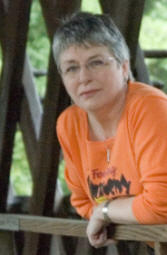 Brenda Sutton is the publisher of Mythic Passages, Operations Director, Corporate Secretary, and Office Administrator for Mythic Imagination Institute. She is an award-winning singer/songwriter with the internationally reknown band Three Weird Sisters. She works in a support and consultant capacity for the non-profit music organization Interfilk, and maintains their website. She is freelance writer whose work has appeared in newspapers and magazines. She is also the mother of five, grandmother of two.
Brenda Sutton is the publisher of Mythic Passages, Operations Director, Corporate Secretary, and Office Administrator for Mythic Imagination Institute. She is an award-winning singer/songwriter with the internationally reknown band Three Weird Sisters. She works in a support and consultant capacity for the non-profit music organization Interfilk, and maintains their website. She is freelance writer whose work has appeared in newspapers and magazines. She is also the mother of five, grandmother of two.
Return to Passages Menu
Subscribe to the Passages e-zine
|

